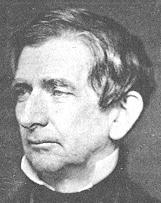William H. Seward
|
|
William Henry Seward (May 16, 1801–October 10, 1872) was United States Secretary of State under Abraham Lincoln and Andrew Johnson.
| Contents [hide] |
Family
His parents were Samuel Sweezy Seward and Mary (Jennings) Seward. He was married to Frances Adeline Miller. They had two daughters and three sons. The daughters were Cornelia Seward (1835-1836) and Frances Adeline (Fanny) Seward (1844-1866). The three sons were William Henry Seward, Jr. (1839-1920), Frederick William Seward (1835-1915) and Augustus Henry Seward (1826-1876).
Education
Seward was born in Florida, New York, a community (which since has incorporated as a village) in Orange County, New York . He attended Union College, studying law, and graduated in 1820, with high honors. He became an abolitionist after observing the conditions of slavery while working in Georgia. He then read law in Florida, New York and Goshen, New York and joined his practice with his father-in-law, Judge Elijah Miller, in Auburn, New York. He stopped his law practice to become a politician when he was elected to the New York senate.
New York politics
Seward served as a state senator of New York from 1831 to 1834, and as Governor of New York from 1839 to 1843. He promoted progressive political policies including prison reform and increased spending on education, including the idea of schools for immigrants taught in their own language and by members of their own religion.
William_H._Seward_-_Project_Gutenberg_eText_15393.jpg
Services to the United States
He was elected United States Senator from New York from 1849 through 1861. In 1849 he won as a Whig and emerged as the leader of its anti-slavery wing. An opponent of the Fugitive Slave Act, he defended runaway slaves in court. In 1850 Seward voted against the Missouri Compromise and claimed in a speech that if slavery were not abolished, America would become embroiled in a civil war. He continued to argue this point of view over the next ten years.
With the decline in the fortunes of the Whig Party, Seward joined the Republican Party in 1855 and was reelected senator from New York. By this time Seward had moderated his views and became less associated with the group known as the Radical Republicans. Seward lost the presidential nomination to John C. Frémont in 1856. He was expected to get the nomination in 1860 but many of the delegates feared that his radical past would prevent him from winning the election. However, radicals such as Horace Greeley also opposed him because they were angry at his shift to the right. When Abraham Lincoln won the nomination Seward loyally supported him and made a long speaking tour of the West in the autumn of 1860.
Abraham Lincoln appointed him Secretary of State in 1861 and he served until 1869. During the War, Seward established a secret police force, which arrested thousands of citizens for disloyalty, nee disagreeing with Lincoln's war policies. Arrested citizens were not told the reason for their arrest, no investigation of their alleged wrongdoing was carried out, and no trials were held. Seward boasted to the British Ambassador, Lord Lyons, that he could have any man arrested in any state for at a whim. Seward survived an assassination attempt on April 14, 1865 (the same night Abraham Lincoln was shot) from Lewis Powell (alias: Lewis Payne), an associate of John Wilkes Booth, who broke into Seward's bedroom and stabbed him repeatedly.
As Secretary of State, he fought for the U.S. purchase of Alaska which he finally negotiated to acquire from Russia for $7,200,000 on March 30, 1867. He had claimed that the United States must move westward. This translated into approximately 2 cents per acre ($4.94 per km²) for 586,412 square miles (1,518,800 km²) of territory, more than twice the size of Texas. The purchase of this frontier land ("Seward's Icebox") was mocked as "Seward's Folly" and Andrew Johnson's "polar bear garden". Currently, Alaska celebrates the purchase on Seward's Day, the last Monday of March.
Later life
He spent his last years traveling and writing. He visited Alaska and went around the world. Seward died in his home in Auburn, New York after a brief illness.
His portrait appeared on the 1891 series U.S. fifty dollar note. The town of Seward, Alaska and the Seward Peninsula, also in Alaska, are named for him, as is Seward Park in Seattle, Washington.
External links
- Seward House, Auburn, NY (http://www.sewardhouse.org)
- Brief Seward biography (http://www.tulane.edu/~latner/Seward.html)
- Brief Seward biography (http://www.u-s-history.com/pages/h168.html)
| Preceded by: William L. Marcy | Governor of New York 1839 – 1843 | Succeeded by: William C. Bouck |
| Preceded by: John A. Dix | United States Senator from New York 1849–1861 | Succeeded by: Ira Harris |
| Preceded by: Jeremiah S. Black | United States Secretary of State March 5, 1861 – March 4, 1869 | Succeeded by: Elihu B. Washburne Template:End boxde:William H. Seward hu:William Henry Seward |

